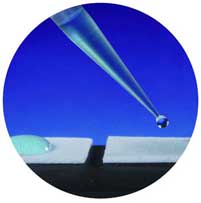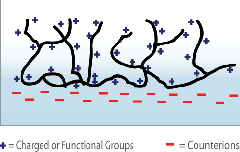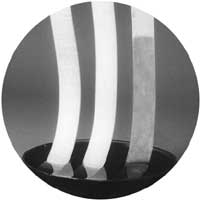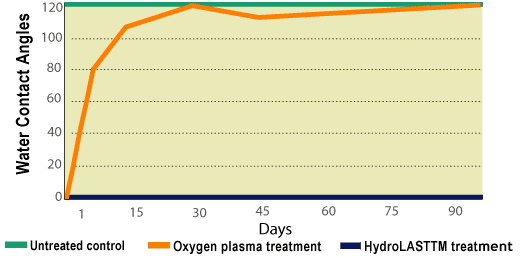|
|
 |
business > medical coating
|
| HydroLAST™ |
| Hydrophilic Surface Treatment |
 |
| HydroLAST™coatings are |
 |
| Hydrophilic: |
 |
| HydroLAST™ coatings improve the wettability and wicking of most polymeric biomaterials. |
 |
| Stable: |
 |
| HydroLAST™ remains effective at pH levels ranging from 2 to 13 for at least 1 year in ambient storage environments. |
 |
| Thin: |
 |
| HydroLAST™ coatings are sub-micron in thickness. They do not alter mechanical or optical properties. |
 |
| Biocompatible: |
 |
| HydroLAST™ is non-toxic as concluded through test methods based on USP XXII. |
 |
| Accepted: |
 |
| Covered by U.S. patents 5,700,559, 5,807,636, and 5,837,377, HydroLAST™ is accepted for use in surgical devices, wicking components of diagnostics, battery separators, and microplates. |
 |
| Reactive: |
 |
| HydroLAST™ coatings contain abundant hydrophilic functional groups that can include hydroxil, carboxyl, or amine functionalities. These reactive sites can be further derivatized for protein or ligand immobilization. |
 |
 |
|
 |
 |
 |
| How does HydroLAST™ work? |
 |
 |
 |
 |
| HydroLAST™ is a process by which hydrophilic polymers are grafted permanently to the surface of a hydrophobic substrate. The hydrophilic polymer has carboxyl, hydroxil, or amine functionalities that serve to loosely bind water. Once treated, the substrate "wets out" and allows water and reagents to flow easily over or through it (in the case of porous substrates). Unlike conventional hydrophilic treatments such as straight plasma, corona, or ozone processing, the surface is permanently rather than transiently hydrophilic. Greater assay accuracies can be achieved, higher throughputs can be realized, and diagnostic process automation can be accomplished. |
|
 |
|
| Enhanced Hydrophilic Properties |
 The photograph on the right illustrates the enhanced hydrophilicity imparted to ultra-high molecular weight polyethylene (UHMWPE) by HydroLAST™. The untreated control does not wick any water. The oxygen treated sample shows some wicking, while the HydroLAST™ treated sample readily wicks water. In many cases, the water contact angle is reduced to zero after processing. This property is important in many diagnostic and medical device applications. Enhanced hydrophilicity is important in industrial applications where restriction of fluid flow creates problems. Examples include battery separators and printing applications. The photograph on the right illustrates the enhanced hydrophilicity imparted to ultra-high molecular weight polyethylene (UHMWPE) by HydroLAST™. The untreated control does not wick any water. The oxygen treated sample shows some wicking, while the HydroLAST™ treated sample readily wicks water. In many cases, the water contact angle is reduced to zero after processing. This property is important in many diagnostic and medical device applications. Enhanced hydrophilicity is important in industrial applications where restriction of fluid flow creates problems. Examples include battery separators and printing applications. |
 |
| Stability |
 |
 |
| The graph on the top illustrates the stability of HydroLAST™. After 90 days of repeated sonication, the water contact angle of treated ultra-high molecular weight polyethylene (UHMWPE) remains at zero. Within a few days, oxygen plasma treated UHMWPE has become essentially hydrophobic with a water contact angle of more than 70 . Shortly thereafter, the contact angle approaches that of the control, namely, a very hydrophobic 120 . At pH levels ranging from 2 to 13 and at elevated temperatures, HydroLAST™ exhibited far superior stability as compared to that of conventional plasma or corona surface treatments. |
 |
| Biocompatibility and Sterilizability |
 |
| HydroLAST™ treated parts can be sterilized by gamma and e-beam sterilization. It is non-toxic and has passed cytotoxicity, direct hemolysis, systemic toxicity, all other biocompatibility tests associated with blood contact devices. |
 |
|

 The photograph on the right illustrates the enhanced hydrophilicity imparted to ultra-high molecular weight polyethylene (UHMWPE) by HydroLAST™. The untreated control does not wick any water. The oxygen treated sample shows some wicking, while the HydroLAST™ treated sample readily wicks water. In many cases, the water contact angle is reduced to zero after processing. This property is important in many diagnostic and medical device applications. Enhanced hydrophilicity is important in industrial applications where restriction of fluid flow creates problems. Examples include battery separators and printing applications.
The photograph on the right illustrates the enhanced hydrophilicity imparted to ultra-high molecular weight polyethylene (UHMWPE) by HydroLAST™. The untreated control does not wick any water. The oxygen treated sample shows some wicking, while the HydroLAST™ treated sample readily wicks water. In many cases, the water contact angle is reduced to zero after processing. This property is important in many diagnostic and medical device applications. Enhanced hydrophilicity is important in industrial applications where restriction of fluid flow creates problems. Examples include battery separators and printing applications.

